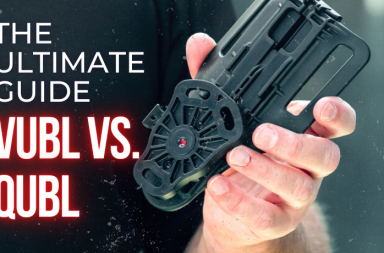Keeping the Future in Sight: Safariland Holsters Integrate RDS.
The use of Red Dot Sights (RDS) on handguns has taken off in the last couple years. What initially appeared to be a niche market is now proving to be a trend, as significant numbers of handgun owners shift away from traditional iron sights, to red dot optics.
Why the rapid switch? It comes down to the ease and speed of target acquisition. Competition shooters were among the first non-military users to take advantage of the RDS system.
“They’re pretty much the proof that it makes you a faster, more accurate shot when utilized with proper, adequate training,” says James Dawson, Duty Gear Category Director at Safariland. “The proof is in the match times. Open class for example, using red dots, will always be much faster than anything like a limited or production class. Although there are several factos, a big part of that is the use of red dot optics.”
“RDS is also very helpful for old eyes,” adds Dawson. “The older your eyes get the more difficult it is to focus on the front sight and superimpose over the target. It takes longer and your eyes take longer to focus.”
As the appetite for RDS systems is increasing in the military, tactical and law enforcement markets, Safariland has moved swiftly to re-engineer holsters to accommodate handguns with red dot optics. Originally, Safariland offered the Docter Optics (DO) series of holsters, in which the dot was situated behind the rear sight.
With RDS becoming more common, firearm manufacturers have instead placed the red dot to a position in front of the rear sight. “Glock was the first mainstream manufacturer to come out with a version of standard off-the-shelf product optimized for red dot,” says Dawson. Smith and Wesson have since introduced an RDS version, and now Sig Sauer has released a red dot optic version of their popular P520. Other companies such as FN and Heckler and Koch are following suit.
To meet market demand, Safariland has released the RDS compatible holster series. Customers can look forward to all of the same retention mechanisms on the Safariland® RDS holster line as existing models. For instance, the 6360 RDS holster has the same features and benefits as the standard 6360, including the Automatic Locking System or ALS®, and the Self Locking System or SLS. “You get the exact retention mechanisms and the exact same straight-up draw, except you can now get a holster that will not just accommodate red dot optics, but also helps protect it,” says Dawson.
Given the expense of RDS systems — they often cost more than the firearm itself — it’s a worthwhile investment to have secure protection. The holsters help safeguard the RDS housing from breakage due to impact, as well as protect the interior of the glass, by preventing dirt, debris and water from getting onto it. This keeps the glass free of debris which would otherwise impede the user’s view, and make it potentially difficult, to see the red dot.
Are there any disadvantages to red dot optics compared to iron sights? “The biggest one is electronics can break, especially when they’re mounted to a slide on a handgun that is reciprocating at a crazy amount of G forces,” says Dawson. “So electronics do break. Batteries wear out. This risk is now at least being mitigated with current raised irons that co-witness through the glass.”
Whether customers prefer traditional iron sights, or red dot optics, Safariland plans to continue to anticipate trends and offer a wide variety of holsters to stay ahead of the demand.
The Safariland RDS holster series is available in duty, tactical and concealment models, with duty and tactical offered in Level I, II and III retention levels. Several Glock fits are available now, with more to come in 2017.






